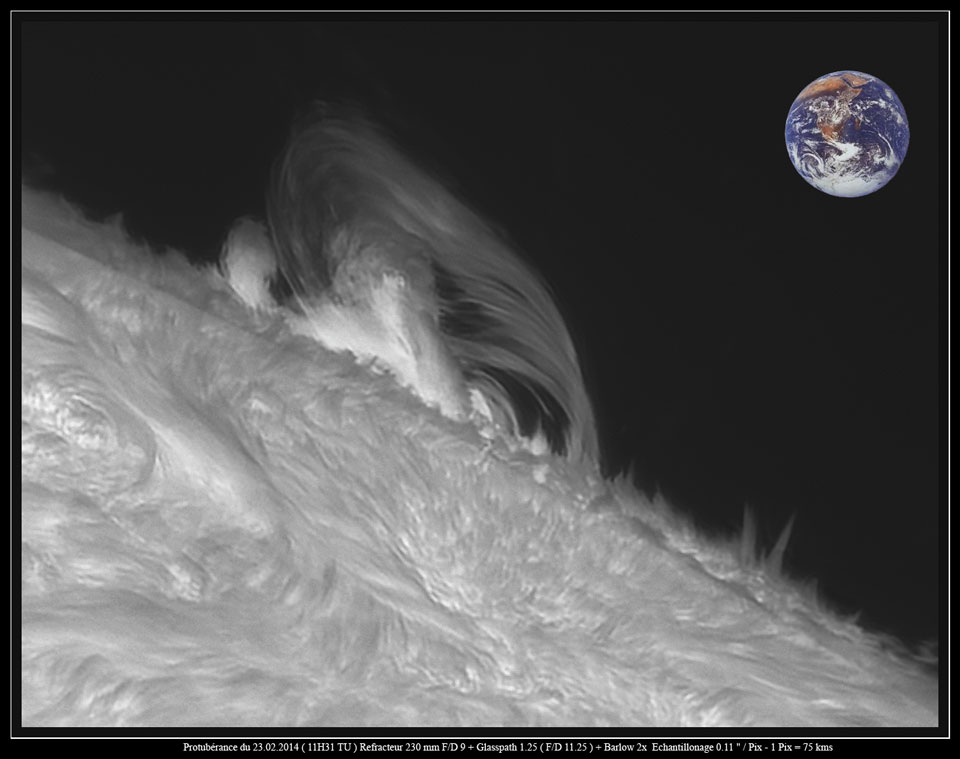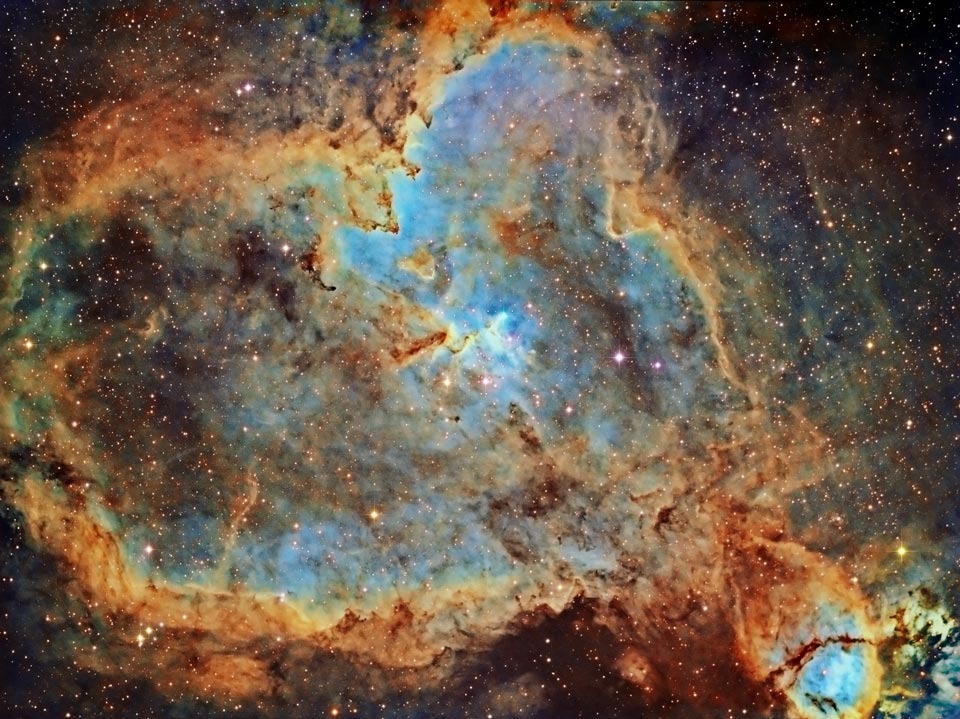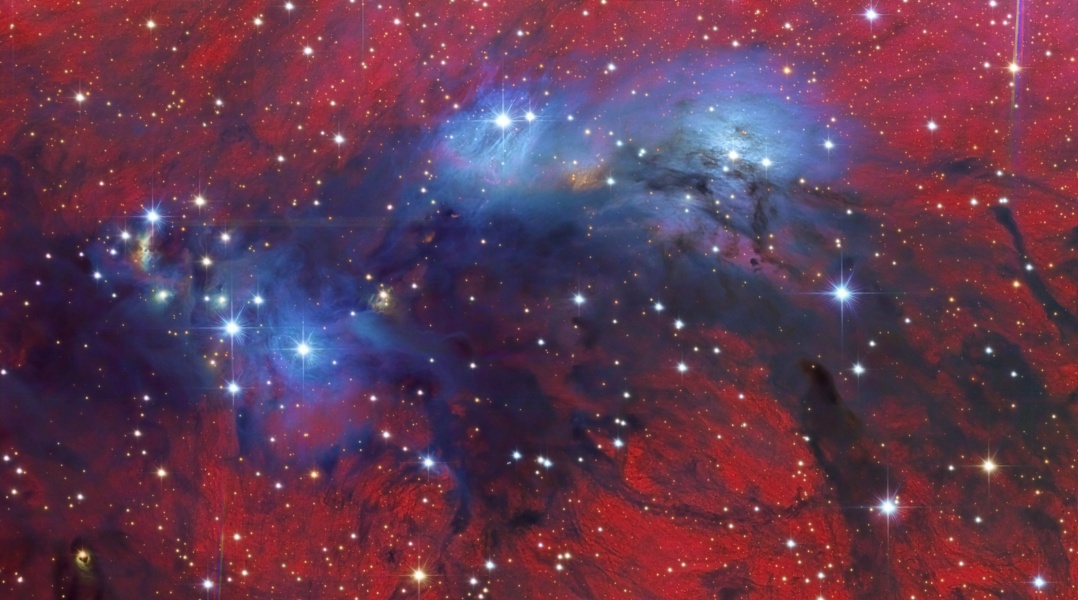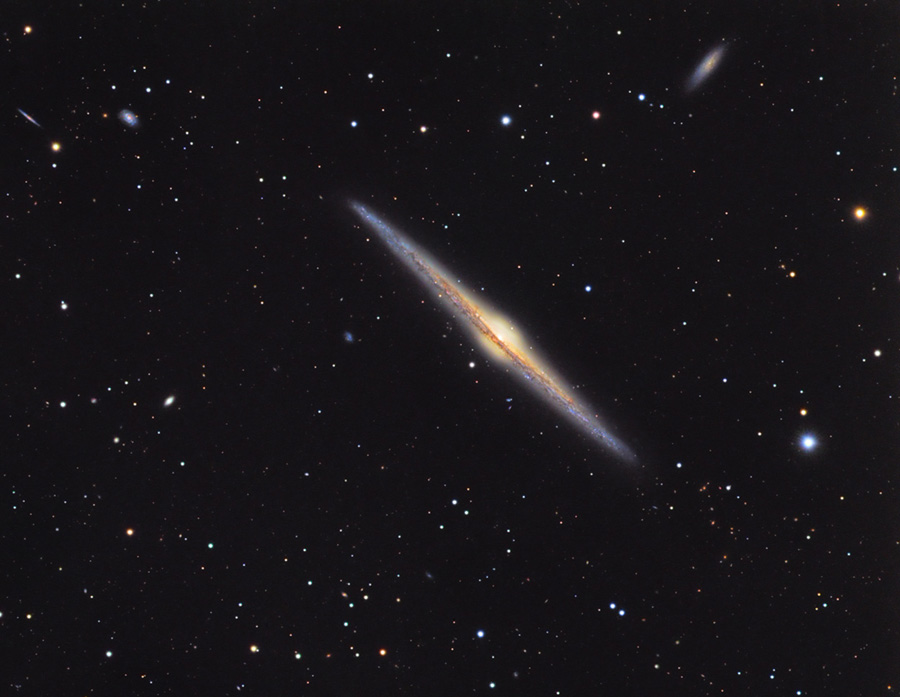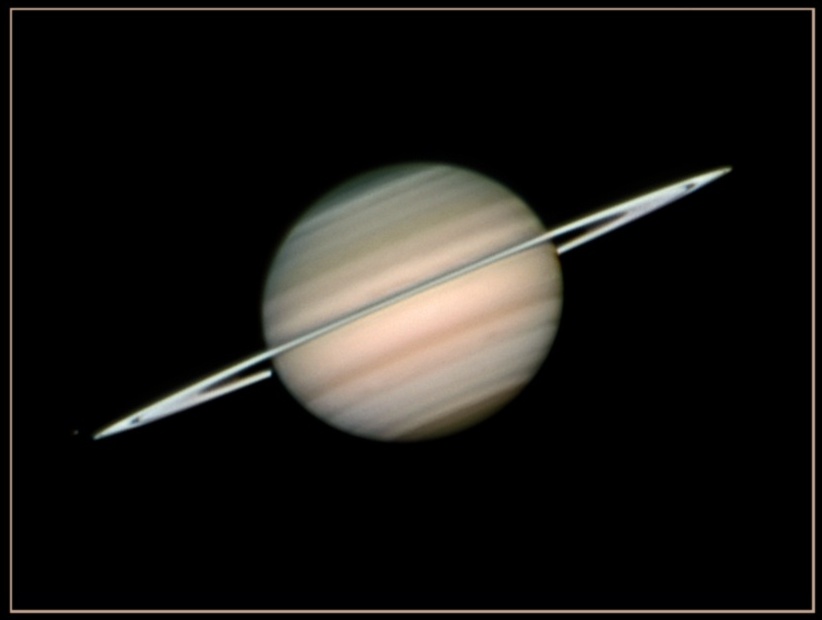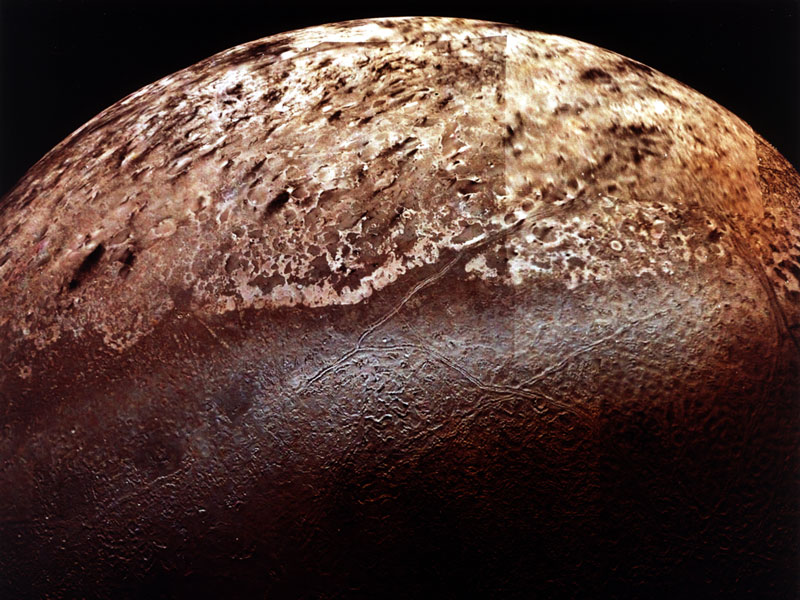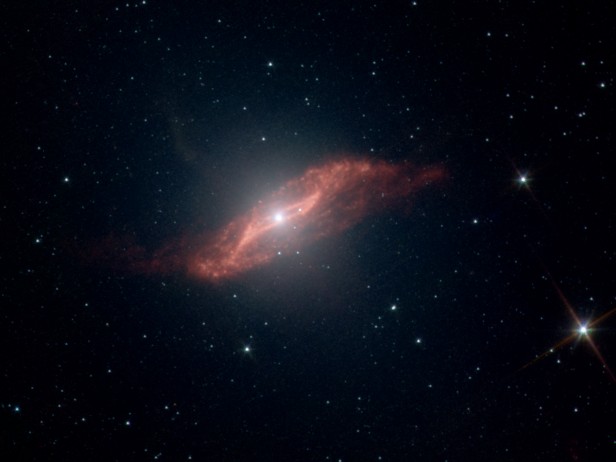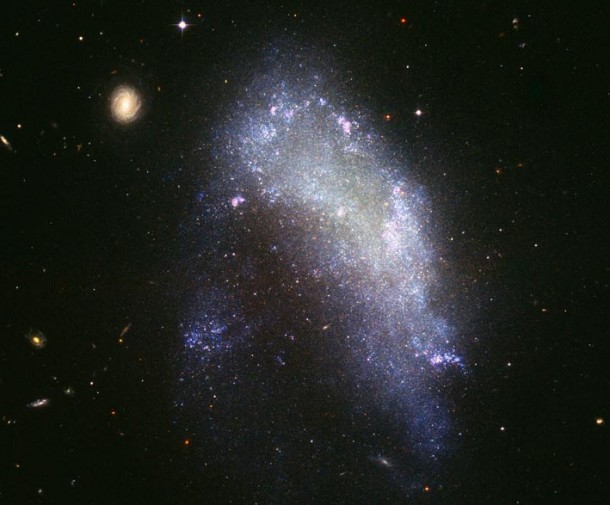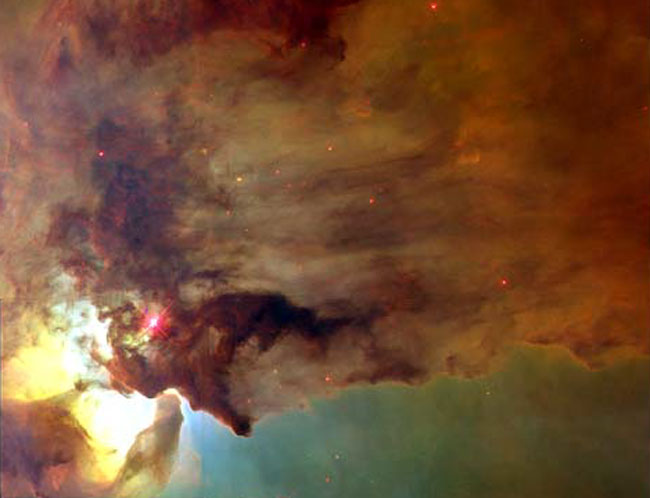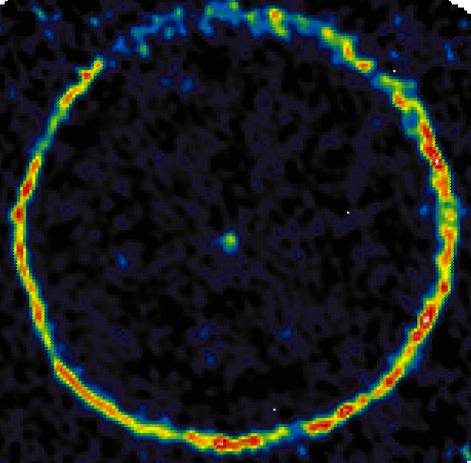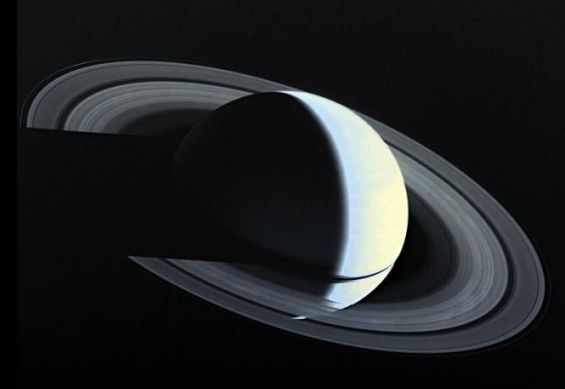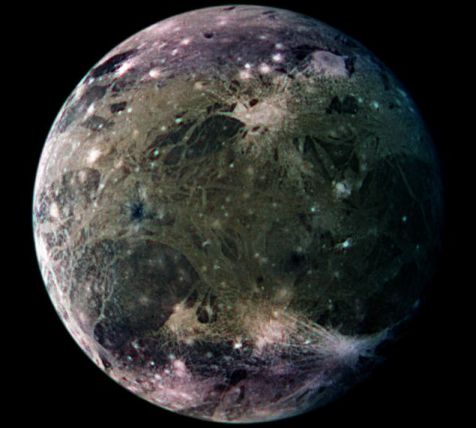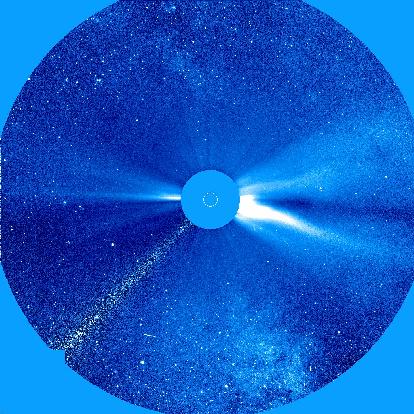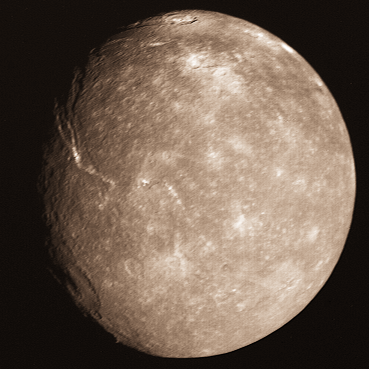| << Previous | Index | Next >> |
2015 What dark structures arise from the Pelican Nebula? Visible as a bird-shaped nebula toward the constellation of a bird (Cygnus, the Swan), the Pelican Nebula is a place dotted with newly formed stars but fouled with dark dust. These smoke-sized dust grains formed in the cool atmospheres of young stars and were dispersed by stellar winds and explosions. Impressive Herbig-Haro jets are seen emitted by a star on the right that is helping to destroy the light year-long dust pillar that contains it. The featured image was scientifically-colored to emphasize light emitted by small amounts of ionized nitrogen, oxygen, and sulfur in the nebula made predominantly of hydrogen and helium. The Pelican Nebula (IC 5067 and IC 5070) is about 2,000 light-years away and can be found with a small telescope to the northeast of the bright star Deneb.
2014 Dramatic prominences can sometimes be seen looming just beyond the edge of the sun. Such was the case last week as a large prominence, visible above, highlighted a highly active recent Sun. A waving sea of hot gas is visible in the foreground chromosphere in great detail as it was imaged in one specific color of light emitted by hydrogen. A solar prominence is a cloud of solar gas held just above the surface by the Sun's magnetic field. The Earth, illustrated in the inset, is smaller than the prominence. Although very hot, prominences typically appear dark when viewed against the Sun, since they are slightly cooler than the photosphere below them. A quiescent prominence typically lasts about a month, and may erupt in a Coronal Mass Ejection (CME) expelling hot gas into the Solar System, some of which may strike the Earth and trigger auroras.
2013 Sprawling across almost 200 light-years, emission nebula IC 1805 is a mix of glowing interstellar gas and dark dust clouds. Derived from its Valentine's-Day-approved shape, its nickname is the Heart Nebula. About 7,500 light-years away in the Perseus spiral arm of our galaxy, stars were born in IC 1805. In fact, near the cosmic heart's center are the massive hot stars of a newborn star cluster also known as Melotte 15, about 1.5 million years young. A little ironically, the Heart Nebula is located in the constellation of the mythical Queen of Aethiopia (Cassiopeia). This deep view of the region around the Heart Nebula spans about two degrees on the sky or about four times the diameter of the Full Moon.
2012 How did spiral galaxy ESO 510-13 get bent out of shape? The disks of many spirals are thin and flat, but not solid. Spiral disks are loose conglomerations of billions of stars and diffuse gas all gravitationally orbiting a galaxy center. A flat disk is thought to be created by sticky collisions of large gas clouds early in the galaxy's formation. Warped disks are not uncommon, though, and even our own Milky Way Galaxy is thought to have a small warp. The causes of spiral warps are still being investigated, but some warps are thought to result from interactions or even collisions between galaxies. ESO 510-13, pictured above digitally sharpened, is about 150 million light years away and about 100,000 light years across.
2011
2010 Magnificent spiral galaxy NGC 4565 is viewed edge-on from planet Earth. Also known as the Needle Galaxy for its narrow profile, bright NGC 4565 is a stop on many telescopic tours of the northern sky, in the faint but well-groomed constellation Coma Berenices. This sharp, colorful image reveals the galaxy's bulging central core cut by obscuring dust lanes that lace NGC 4565's thin galactic plane. An assortment of other galaxies is included in the pretty field of view. Neighboring galaxy NGC 4562 is at the upper right. NGC 4565 itself lies about 40 million light-years distant, spanning some 100,000 light-years. Easily spotted with small telescopes, sky enthusiasts consider NGC 4565 to be a prominent celestial masterpiece Messier missed.
2009 Very good telescopic views of Saturn can be expected in the coming days as the ringed planet nears opposition on March 8th, its closest approach to Earth in 2009. Of course, opposition means opposite the Sun in planet Earth's sky - an arrangement that occurs almost yearly for Saturn. But while Saturn itself grows larger in telescopic images, Saturn's rings seem to be vanishing as their tilt to our line-of-sight decreases. In fact, the rings will be nearly invisible, edge-on from our perspective, by September 4. Recorded on February 28, this sharp image was made with the 1 meter telescope at Pic Du Midi, a mountain top observatory in the French Pyrenees. The rings are seen to be tilted nearly edge-on, but remarkable details are visible in the gas giant's cloud bands. The icy moon Tethys appears just beyond the rings at the lower left.
2008 Nebulae are perhaps as famous for being identified with familiar shapes as perhaps cats are for getting into trouble. Still, no known cat could have created the vast Cat's Paw Nebula visible in Scorpius. At 5,500 light years distant, Cat's Paw is an emission nebula with a red color that originates from an abundance of ionized hydrogen atoms. Alternatively known as the Bear Claw Nebula or NGC 6334, stars nearly ten times the mass of our Sun have been born there in only the past few million years. Pictured above, the end of the Cat's Paw nebula was imaged from the Blanco 4-meter Telescope in Chile.
2007 In October of 1846, William Lassell was observing the newly discovered planet Neptune. He was attempting to confirm his observation, made just the previous week, that Neptune had a ring. But this time he discovered that Neptune had a satellite as well. Lassell soon proved that the ring was a product of his new telescope's distortion, but the satellite Triton remained. The above picture of Triton was taken in 1989 by the only spacecraft ever to pass Triton: Voyager 2. Voyager 2 found fascinating terrain, a thin atmosphere, and even evidence for ice volcanoes on this world of peculiar orbit and spin. Ironically, Voyager 2 also confirmed the existence of complete thin rings around Neptune - but these would have been quite invisible to Lassell!
2006 Peering deep inside Centaurus A, the closest active galaxy to Earth, the Spitzer Space Telescope's penetrating infrared cameras recorded this startling vista in February 2004. About 1,000 light-years across, the twisted cosmic dust cloud apparently shaped like a parallelogram is likely the result of a smaller spiral galaxy falling into the giant Centaurus A. The parallelogram lies along the active galaxy's central band of dust and stars visible in more familiar optical images. Astronomers believe that the striking geometric shape represents an approximately edge-on view of the infalling spiral galaxy's disk in the process of being twisted and warped by the interaction. Ultimately, debris from the ill-fated spiral galaxy should provide fuel for the supermassive black hole lurking at the center of Centaurus A.
2005 In this tantalizing image, young blue star clusters and pink star-forming regions abound in NGC 1427A, a galaxy in motion. The small irregular galaxy's swept back outline points toward the top of this picture from the Hubble Space Telescope - and that is indeed the direction NGC 1427A is moving as it travels toward the center of the Fornax cluster of galaxies, some 62 million light-years away. Over 20,000 light-years long and similar to the nearby Large Magellanic Cloud, NGC 1427A is speeding through the Fornax cluster's intergalactic gas at around 600 kilometers per second. The resulting pressure is giving the galaxy its arrowhead outline and triggering the beautiful but violent episodes of star formation. Still, it is understood that interactions with cluster gas and the other cluster galaxies during its headlong flight will ultimately disrupt galaxy NGC 1427A. Many unrelated background galaxies are visible in the sharp Hubble image, including a striking face-on spiral galaxy at the upper left.
2004
[imghover6=http://apod.nasa.gov/apod/image/0403/cm ... ner_c1.jpg]http://apod.nasa.gov/apod/image/0403/cm ... er_lab.jpg[/imghover6]Credit & Copyright: David Cortner
2003 The center of the Lagoon Nebula is busy with the awesome spectacle of star formation. Visible in the lower left, at least two long funnel-shaped clouds, each roughly half a light-year long, have been formed by extreme stellar winds and intense energetic starlight. The tremendously bright nearby star, Hershel 36, lights the area. Vast walls of dust hide and redden other hot young stars. As energy from these stars pours into the cool dust and gas, large temperature differences in adjoining regions can be created generating shearing winds which may cause the funnels. This picture, spanning about 5 light years, was taken in 1995 by the orbiting Hubble Space Telescope. The Lagoon Nebula, also known as M8, lies about 5000 light years distant toward the constellation of Sagittarius.
2002 NASA's Crawler-Transporters are the largest tracked vehicles in existence. Although the crawlers pack over 5,000 horsepower, their top speed is less than two kilometers per hour when fully loaded. Eleven people are needed to drive a single crawler. Diesel fuel mileage is about 350 liters per kilometer (less than 0.007 miles per gallon). The crawler's function is to move NASA's space shuttles -- complete with launch platforms -- from the Assembly Building to the Launch Pad at Kennedy Space Center in Florida, USA. Two of these massive machines have operated since the Apollo era and have now crawled over 4,000 kilometers, all the while keeping their contents perfectly upright. In this picture a crawler transports the shuttle Columbia to the pad prior to its March 1st launch on the latest Hubble Space Telelescope Servicing Mission.
2001 TT Cygni is a cool red giant star with a wind. This false-color picture of TT Cyg was made using a coordinated array of millimeter wavelength radio telescopes and shows radio emission from carbon monoxide (CO) molecules in the surrounding gas. The central emission is from material blown off the red giant over a few hundred years while the thin ring, with a radius of about 1/4 light-year, actually represents a shell of gas expanding outward for 6,000 years. Carbon stars like TT Cyg are so named for their apparent abundance of carbon containing molecules. The carbon is likely the dredged-up ashes of nuclear helium burning in the stellar interior. Carbon stars lose a significant fraction of their total mass in the form of a stellar wind which ultimately enriches the interstellar gas - the source of material for future generations of stars. TT Cyg is about 1,500 light-years away in the constellation Cygnus.
2000 From a spectacular vantage point over 1.4 billion kilometers from the sun, the Voyager 1 spacecraft looked back toward the inner solar system to record this startling view of Saturn's nightside. The picture was taken on November 16, 1980, some four days after the robot spacecraft's closest approach to the gorgeous gas giant. The crescent planet casts a broad shadow across its bright rings while the translucent rings themselves can be seen to cast a shadow on Saturn's cloud tops. Since Earth is closer to the sun than Saturn, only Saturn's dayside is visible to Earth-bound telescopes which could never take a picture like this one. After this successful flyby two decades ago, Voyager 1 has continued outward bound and is presently humanity's most distant spacecraft. The next spacecraft to approach Saturn will be Cassini, on course to arrive in 2004.
1999 Ganymede, one of the four Galilean moons of Jupiter, is the largest moon in the Solar System. With a diameter of 5,260 kilometers it is even larger than planets Mercury and Pluto and just over three quarters the size of Mars. Ganymede is locked in synchronous rotation with Jupiter. This detailed mosaic of images from the Galileo spacecraft shows the trailing hemisphere of this planet-sized moon. Speckled with bright young craters, Ganymede's surface shows a mixture of old, dark, cratered terrain and lighter regions laced with grooves and ridges. Ganymede's true colors tend toward subtle browns and grays, but this mosaic's colors have been enhanced to increase surface contrasts. The violet shades extending from the top and bottom are likely due to frost particles in Ganymede's polar regions.
1998 Higher than the highest mountain, higher than the highest airplane, lies the realm of the aurora. Aurora rarely reach below 60 kilometers, and can range up to 1000 kilometers. Aurora light results from solar electrons and protons striking molecules in the Earth's atmosphere. Frequently, when viewed from space, a complete aurora will appear as a circle around one of the Earth's magnetic poles. The above photograph was taken in January in Alaska and shows a spectacular aurora borealis above a frozen landscape which includes spruce trees and the photographer's truck. The picture had to be taken quickly as the temperature was below -40 degrees.
1997 The Sun is bright, so bright that it overwhelms the light from other stars even for most satellite-borne telescopes. But LASCO, a coronograph onboard the space-based SOHO Observatory, uses occulting disks to block the intense solar light and examine the tenuous, hot gases millions of miles above the Sun's surface. In this LASCO image from December 24, 1996, an occulting disk (center) and mechanical support (extending from the lower left) are visible along with the billowing Solar Wind. Appearing in the background are faint stars and obscuring dust clouds toward the center of our Milky Way Galaxy! The field of view covers about 16 degrees, corresponding to 28 million miles at the distance of the Sun - just under half the diameter of Mercury's orbit. A prominent dark interstellar dust cloud cuts through the Milky Way starfield running approximately south (lower right) to north. Blemishes on the image are camera streaks caused by charged particles.
1996 Titania's tortured terrain is a mix of valleys and craters. NASA's interplanetary robot spacecraft Voyager 2 passed this moon of Uranus in 1986 and took the above photograph. The photograph was then transmitted back to earth by radio. The valleys of Titania resemble those on Ariel indicate that Titania underwent some unknown tumultuous resurfacing event in its distant past. Although Titania is Uranus' largest moon, it is still much smaller than Triton - the largest moon of Uranus' sister planet Neptune. Titania is essentially a large dirty iceball that orbits Uranus - it is composed of about half water-ice and half rock. Titania was discovered by William Hershel in 1787.
| << Previous | Index | Next >> |

